Winston Churchill is undoubtedly Britain’s most revered politician. He was born in 1874 at Blenheim Palace as a member of a major aristocratic family and is buried in a modest grave nearby. His statue stands opposite the clock, which everybody refers to as Big Ben (actually the name of the bell behind the clock). Chartwell, his house in Kent, is is an important money earner for the National Trust, who welcome around a quarter of a million visitors there every year.
 Statue of Sir Winston Churchill in Parliament Square in London.
Statue of Sir Winston Churchill in Parliament Square in London.
Churchill, who never went to university, claimed to be a bit of a dunce and served in the British army in the late Imperial Wars. He and his deputy and successor Clement Attlee had both served as uniformed officers in the First World War and knew about the life of a soldier under fire, the last Prime Ministers of Britain to have seen action. Churchill had pioneered the unsuccessful Gallipoli campaign and then left politics for a time to fight in the trenches.
Winston Churchill was an irrepressible politician, however, and soon returned to political life. He was not tempted, as many of his contemporaries were, to praise the efforts of Adolf Hitler to return Germany to greatness and realised before many others the threat posed by Nazism. He was, therefore, ideally placed to take over as Prime Minister after Neville Chamberlain, who had tried to come to an agreement with Hitler, stepped down. Chamberlain’s promise of ‘peace in our time’ had proved a hollow one and, despite being lauded at the time of the Munich agreement forged with Nazi Germany, soon lost credibility as leader of a free Britain.
Churchill took over as Prime Minister in 1940, and while the Commonwealth countries were on the British side in the war, this country stood alone in the European theatre of war. Germany was in alliance with Russia until Hitler foolishly ordered an invasion of that country. He had conquered France and much of Europe. Germany dominated Europe and seemed to be unbeatable. This was before Pearl Harbour, so the USA was not involved.
As Britain stood alone in the European theatre of war, the young pilots of the Royal Air Force came to the country’s rescue and beat back the waves of Luftwaffe planes that tried to gain control of the air in preparation for a German invasion of Britain, codenamed Operation Sea Lion which, fortunately, never came about. It is difficult to conquer an island nation, and Churchill organised the defence of the country brilliantly during the time known as the Blitz.
 Churchill War Rooms – New Entrance. Photo credit: © Imperial War Museum.
Churchill War Rooms – New Entrance. Photo credit: © Imperial War Museum.
Churchill also had a close relationship with American President Franklin Delano Roosevelt, who was half-American himself. His mother had been born Jenny Jerome and was from a wealthy banking family that had married into the British aristocracy. Churchill was devoted to his mother but had a difficult relationship with his father Randolph, who never lived to see his triumphs. Randolph died at the age of forty-five in 1895, the ‘nearly man’ of British politics.
It seemed like his son Winston might also turn out to be a nearly man in political life until the challenge of combating Nazism came about. He was, by this time, well into his sixties and might have been contemplating retirement where he could indulge in his hobby of painting. Some of his paintings can be seen at Chartwell, and he was exhibited at the Royal Academy summer exhibition, which showcases the work of non-professional artists.
When he was on the verge of retiring from the Prime Ministership of Britain, the House of Commons, where he had made so many of his famous speeches, presented Churchill with a portrait by the distinguished contemporary artist Graham Sutherland. Churchill hated this painting and he and his wife Clementine are believed to have destroyed it, a scene recreated in the television series The Crown in which Churchill was portrayed by John Lithgow.
Other portraits of Churchill survive, and one that he particularly liked was a simple pen-and-ink drawing by the artist Paul Trevillion. At the time, Trevillion was in his early twenties and nervously approached Churchill and asked to portray him. Churchill took a shine to this work and even agreed to sign it. Trevillion, who said that Churchill’s birthday was ‘ruined’ by the Sutherland episode, intends to auction the painting for around a million pounds.
Lithgow is just one of many actors who has portrayed Winston Churchill in film or television. Others include Richard Burton, Albert Finney, Brian Cox, Robert Hardy, Timothy Spall and Gary Oldman, who won an Oscar for his portrayal in the film Darkest Hour. It is almost a rite of passage for a major actor to portray this famous statesman. Churchill even makes appearances in the popular TV series Doctor Who and Nye, a play about Aneurin Bevan.
 Pen and ink drawing of Sir Winston Churchill by Paul Trevillion.
Pen and ink drawing of Sir Winston Churchill by Paul Trevillion.
In fact, Winston Churchill does not come out too well in Nye and is portrayed as a political fixer. Nye Bevan, who later founded the National Health Service, votes for him a confidence motion in the House of Commons in order to convince Roosevelt that Churchill had the full backing of the British parliament in a bid to bring the USA into the war. The US did eventually join the British effort in the war and played a major part in defeating the Nazis and the Japanese.
Churchill’s record as a wartime leader is untouchable and rightly revered, but his record as a peacetime Prime Minister is more mixed. He was defeated in the post-war election of 1945. He had expected to sail to victory in the wake of defeating Hitler but the British chose his deputy Clement Attlee and elected a Labour government after the war in Europe ended. It was in the days before opinion polls and many still express surprise at Churchill’s defeat.
However, as Churchill well knew, Britain has a parliamentary not a presidential system and, much as the British people revered him as the man who defeated Hitler, they also felt it was time for a change and duly elected a socialist government which, amongst other things, set up the NHS, which Churchill had opposed. It is now a mainstay of life in Britain and Churchill would have been the first to accept that times had changed since his ‘finest hour.’







Leave a Reply